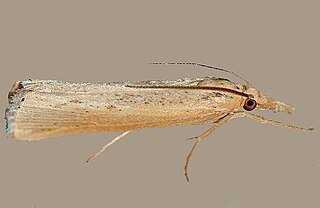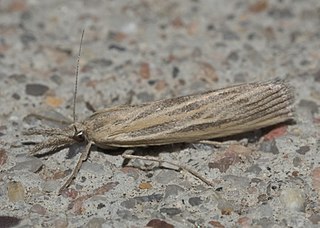Mesolia is a genus of moths of the family Crambidae described by Émile Louis Ragonot in 1889.

Xubida is a genus of moths of the family Crambidae.

Prionapteryx is a genus of moths of the family Crambidae.

Tehama is a genus of moths of the family Crambidae. It contains only one species, Tehama bonifatella, the western lawn moth, which is found in Greenland and North America, where it has been recorded from Alberta, British Columbia, California, Colorado, Labrador, Manitoba, Nevada, Quebec and Washington. The habitat consists of grasslands.

Thaumatopsis is a genus of moths of the family Crambidae.
Caloreas is a genus of moths in the family Choreutidae.

Chrysoteuchia topiarius, the topiary grass-veneer moth, subterranean sod webworm or cranberry girdler, is a moth of the family Crambidae. The species was first described by Philipp Christoph Zeller in 1866. It is found in most of North America.
Crambus cockleellus is a moth in the family Crambidae. It was described by William D. Kearfott in 1908. It is found in North America, where it has been recorded from Alberta and British Columbia.

Crambus leachellus, or Leach's grass-veneer, is a moth in the family Crambidae. It was described by Johann Leopold Theodor Friedrich Zincken in 1818. It is found in North America, where it has been recorded from Ontario and Maryland to Florida, west to California and Oregon. The habitat consists of grasslands and meadows.
Crambus youngellus, or Young's grass-veneer, is a moth in the family Crambidae. It was described by William D. Kearfott in 1908. It is found in North America, where it has been recorded from north-eastern United States and southern Ontario.
Fissicrambus intermedius is a moth in the family Crambidae. It was described by William D. Kearfott in 1908. It has been recorded from the US states of Arizona, California and Texas.

Pediasia dorsipunctella is a moth in the family Crambidae. It was described by William D. Kearfott in 1908. It is found in North America, where it has been recorded from Alberta, Arizona, California, Manitoba, Montana, Nevada, North Dakota and Ontario. The habitat consists of grasslands.
Thaumatopsis atomosella is a moth in the family Crambidae. It was described by William D. Kearfott in 1908. It is found in the US states of Arizona and California.
Thaumatopsis bolterellus is a moth in the family Crambidae. It was described by Charles H. Fernald in 1887. It is found in North America, where it has been recorded from New Mexico and Texas.
Thaumatopsis crenulatella is a moth in the family Crambidae. It was described by William D. Kearfott in 1908. It is found in the US states of Arizona, California, Colorado and Nevada.
Thaumatopsis fernaldella is a moth in the family Crambidae. It was described by William D. Kearfott in 1905. It is found in North America, where it has been recorded from Alberta, California, Florida, Maryland, Mississippi, Nevada, New Mexico, Oklahoma, Saskatchewan and Texas. The habitat consists of prairies.
Thaumatopsis floridella, the Floridian grass-veneer, is a moth in the family Crambidae. It was described by William Barnes and James Halliday McDunnough in 1913. It is found in North America, where it has been recorded from coastal areas in Florida, Georgia, Mississippi, South Carolina and North Carolina, New Jersey, New York, and Rhode Island. It is also found in Cuba.
Xubida puritellus is a moth in the family Crambidae. It was described by William D. Kearfott in 1908. It is found in the US state of Arizona.
Mesolia huachucaella is a moth in the family Crambidae. It was described by William D. Kearfott in 1908. It is found in the US state of Arizona.
Prolita invariabilis is a moth of the family Gelechiidae. It was described by William D. Kearfott in 1908. It is found in the US states of Utah, Wyoming, Arizona, California, Colorado, Oregon and New Mexico.






